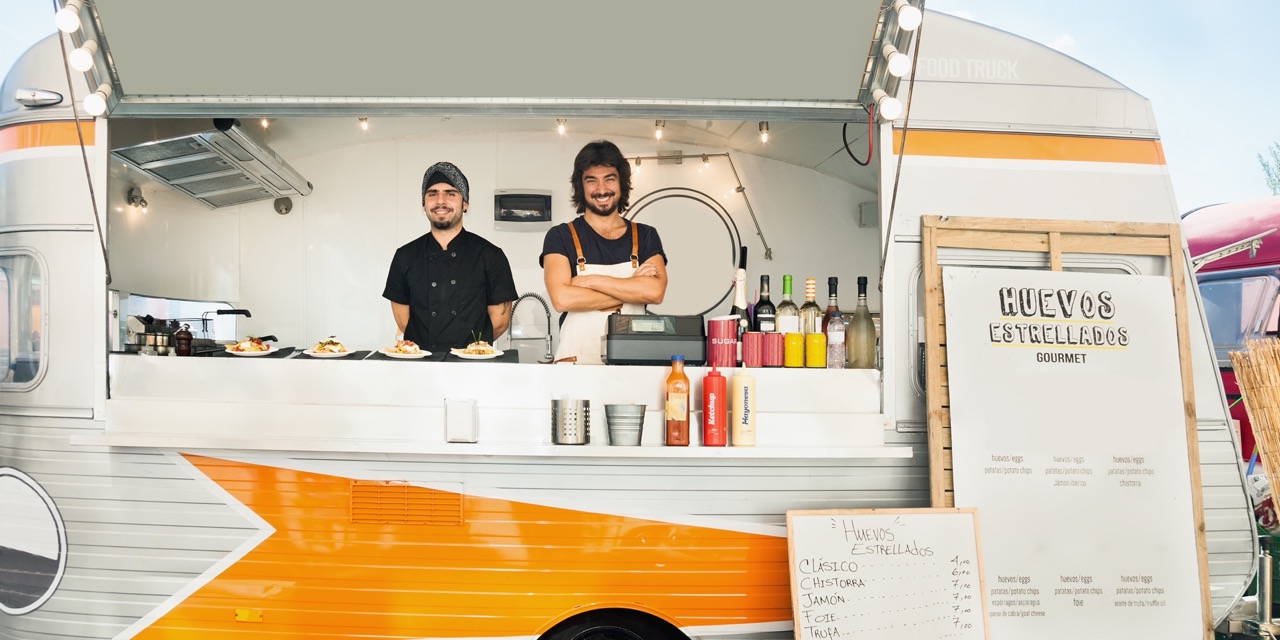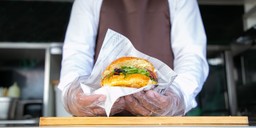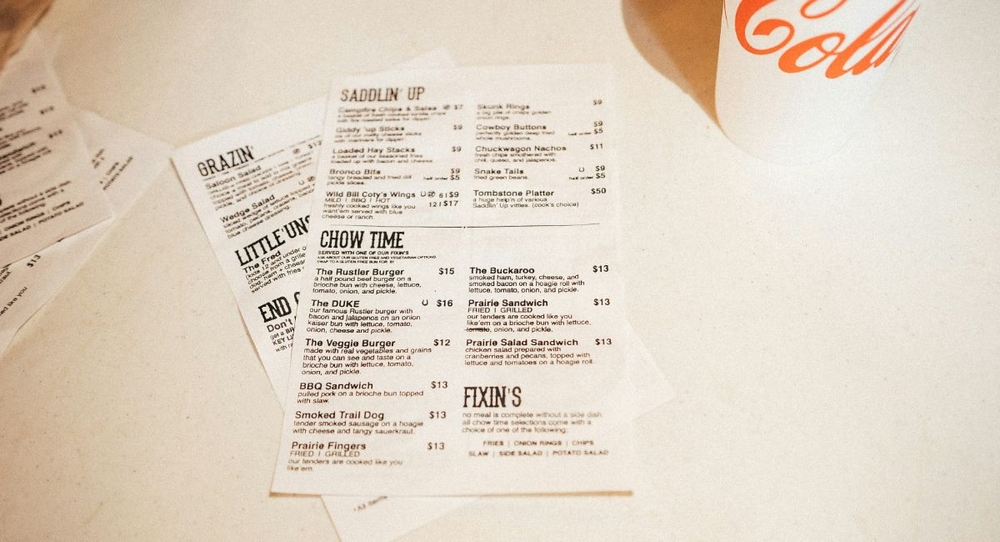Food Truck Design Essentials | A Guide
Table of Contents

Whether they’re serving up tacos, tonkatsu, or tagliatelle, food trucks are a staple across the nation. With over 36,000 food trucks operating in the US alone, there’s plenty of choice for hungry customers no matter where they are.
For food truck owners, however, all those options also mean a plethora of players in the mobile meal market. In other words, competition is extra tight in the food truck industry.
To make the most out of your small space and help your business stand out to hungry patrons, you’ll need to carefully consider your truck’s layout and aesthetics. From space-saving equipment to an eye-catching exterior, we’re serving up the essential ingredients for an efficient and inviting food truck design.
The basics: what’s in a food truck?
Food trucks don’t just come off the line ready to whip up mouthwatering meals. There are no ovens, deep fryers, or flattops in factory models—just engines and an empty shell to customize how you see fit. So, any vehicle could (in theory) become a food truck.
Due to their sufficient space and relative availability, however, step vans are generally the most common choice for restaurateurs looking to hit the open road. You might be familiar with them as postal delivery vehicles or armored trucks, but they function equally well as mobile eateries.
Three of the most popular step van models for food truck proprietors to choose from include:
- The Chevrolet P30
- The Freightliner MT45
- The Ford P700
All of these vans come in 14 to 18-foot lengths and have sufficient suspension and engine power to haul your equipment, ingredients, and staff. They’re classed as medium-duty trucks and, generally, most vehicles in this category will work wonderfully as a base for your business.
Choosing a truck, however, is only the beginning. Once you’ve got your motor and metal box, you’ll need to outfit it with the equipment you’ll use to serve up delectable dishes. Depending on the type of food you want to offer, that can mean a wide range of potential appliances and tools to install.
Getting equipped: appliances and tools for restaurants in motion
What you choose to serve your customers directly dictates the kind of equipment and supplies you’ll need for your food truck.
Burgeoning baristas hoping to serve coffee, for instance, won’t need a flattop, deep fryer, or oven. Instead, they’d need more specialized equipment, such as:
- Bean roasters
- Grinders
- Coffee pots, espresso machines, and other extraction devices
- Special tools for steaming milk, making latte art, and performing other classic coffee shop tasks
When people think about food trucks, however, they’re usually not thinking about a quick cup of joe. These mobile restaurants generally serve up items like french fries, falafel, and other fast food sensations.
But that’s not to say they can’t be high-end either. One New York food truck, for instance, infamously offered a nearly $700 burger featuring:
- Kobe beef
- Foie gras
- Caviar
- Lobster
- Truffles
- Gruyere cheese melted with champagne steam
- Himalayan rock salt
Whether you’re going for luxury or value, the equipment you use to cook will likely be the same as it would be in a brick-and-mortar spot. The mobile nature of the food truck industry, however, does warrant some special considerations when purchasing appliances.
Tips for purchasing and placing essential equipment
Assuming you’ve got a step van like one of the models mentioned above and the two front seats are in place, you’ll likely have around 70 to 80 square feet of room behind the scenes.
That’s not a lot of space to work with considering the average commercial kitchen in a brick-and-mortar restaurant is over 1,000 square feet. Nonetheless, there should still be enough room to maneuver around if you’re selective about your equipment size and placement.
Depending on your menu, you may need to purchase and install:
- Flattops: Whether you’re searing steaks or frying fajitas, a flattop griddle is a solid investment in space and equipment for food truck proprietors. With lengths ranging anywhere from 14 to 72 inches, it’s up to you to decide how much grill room your menu requires. For maximum space efficiency, consider a food truck-specific model with refrigerated drawers mounted at the base.
- Refrigerators: Speaking of refrigeration, keeping everything cool can be quite the challenge in a small, constantly-heated metal box. Nevertheless, the United States Department of Agriculture (USDA) calls for temperatures of 40℉ or lower for raw ingredients such as meat and vegetables. To keep everything cold in your compact area, consider chest-style refrigerator models that can double as counter space for prep work.
- Deep fryers: Most food trucks have at least a few deep-fried offerings on their menus. Despite this, big vats of boiling-hot oil aren’t necessarily the best fit for large, rolling workstations. To prevent spillage when moving between spots, ensure you pick a model with a solid, weighted cover to keep everything in place as you cruise down the highway.
- Ovens: Ovens are notoriously bulky and will take up a ton of valuable real estate in the back of your truck. If you’re just toasting buns or performing other similar, simple tasks, opt for a broiler or Salamander. If fresh-baked is the basis of your menu, however, seek out a thin, upright commercial-style oven that occupies more space vertically than horizontally.
- Burners: If you already have extra space on your flattop, then you don’t necessarily need to install conventional burners as well. If sauteing is central to your menu, however, consider what other pieces of equipment can be 86ed in favor of burners.
- Other equipment: From blenders to food processors and rice cookers, your menu’s specifics can necessitate a variety of smaller appliances. Just remember that space is minimal, so consider how you can reduce your equipment needs by performing prep tasks in a secondary location.
To make sure everything stays working on the go, seek out gas-powered appliances such as those fueled by propane. And, when placing them, remember the general function and purpose of a food truck to find the perfect space.
You’ll want to minimize any clutter between you and your customers at the takeout window, so putting your appliances in a line behind and next to the ordering area is a common tactic for food truck layouts. You’ll also want to keep sufficient space in the center aisle for walking and turning around, so try to opt for thin appliances when possible.
Food trucks likewise need a storage solution for knives, cutting boards, and other small hand tools—and, depending on how bumpy the roads are in your area, conventional hooks might not cut it. So, be sure to factor in drawer space when dreaming up your food truck’s layout.
The outside matters too: amplifying your food truck’s aesthetics
Having a functional, space-conscious layout is essential for cooking fantastic food on the go. But your customers will barely get a glimpse beyond your ordering window. This means they’ll judge your truck by its exterior aesthetics—so make sure they’re interesting and inviting.
Red has been found by multiple studies to be the most eye-catching and emotionally evocative color. It’s also said to elicit feelings of hunger and impulsiveness in onlookers, making it a perfect choice for enticing them into grabbing a quick bite.
Red doesn’t necessarily fit every restaurateur’s aesthetic, however. If you’re looking for a different color scheme that meets your vision for your food truck, some of the other most eye-catching tones include:
- Pink
- Blue
- Yellow
- Orange
- Purple
Color is only one of the many food truck ideas that reflect your branding. To stand out from other vendors and stick in the minds of hungry customers, you’ll need a catchy name that reflects your style and what you serve. Some of America’s most popular food trucks can (at least in part) attribute much of their success to their snappy names, including:
- The Cow and Curd (Philadelphia-area purveyors of fried cheese curds)
- Ms. Cheezious (Miami-based melt-maker)
- Cinnamon Snail (NYC’s premier vegan food truck)
Pick a mouthwatering, memorable name to reel customers in and, after they order, your delicious meals will speak for themselves. And, if you want your customers to have easier access to your delicacies wherever they are, consider starting a ghost kitchen instead of a food truck.
Rethink food service in a ghost kitchen from CloudKitchens
Typical food trucks rely on customers leaving their homes and heading to specific spots to get their food. Studies show, however, that this is a dated model. While food delivery services have been experiencing exponential growth in recent years, restaurant traffic continues to fall.
Luckily, there’s a rising business model that delivers customers their food as they want it while maintaining the DIY feel of a conventional food truck: ghost kitchens.
Ghost kitchens, such as those from CloudKitchens, allow you to serve customers your exceptional food in the comfort of their own homes. What’s more, they don’t require you to think about food truck design, invest in expensive equipment, or cook in cramped quarters.
Start your ghost kitchen with CloudKitchens to forego the literal ups and downs of bouncing around in a food truck, and begin serving your customers in weeks.
Explore ghost kitchen locations across the US:
- Ghost kitchens in San Francisco
- Ghost kitchens in LA
- Ghost kitchens in NYC
- Ghost Kitchens in Toronto
- Ghost Kitchens in Atlanta
- Ghost Kitchens in Dallas
- Ghost Kitchens in Chicago
- Ghost Kitchens in Denver
- Ghost Kitchens in Miami
| DISCLAIMER: This information is provided for general informational purposes only and the content does not constitute an endorsement. CloudKitchens does not warrant the accuracy or completeness of any information, text, images/graphics, links, or other content contained within the blog content. We recommend that you consult with financial, legal, and business professionals for advice specific to your situation. |
Sources:
Zippia. 21 IMPORTANT FOOD TRUCK STATISTICS [2023]: ANALYSIS, TRENDS, AND PROJECTIONS. https://www.zippia.com/advice/food-truck-statistics/
Food Liability Insurance Program. How to Pick the Best Vehicle for Your Food Truck. https://www.fliprogram.com/blog/how-to-pick-the-best-vehicle-for-your-food-truck.
The New York Times. At $666, The World’s Most Expensive Burger Is Served with a Side of Shame. https://newsfeed.time.com/2012/07/17/at-666-this-devilish-new-burger-is-also-the-worlds-most-expensive/.
Square. How to Cook Up a Great Restaurant Floor Plan. https://squareup.com/us/en/the-bottom-line/operating-your-business/how-to-create-a-restaurant-floor-plan.
United States Department of Agriculture. Refrigeration & Food Safety. https://www.fsis.usda.gov/food-safety/safe-food-handling-and-preparation/food-safety-basics/refrigeration
National Library of Medicine. The color red attracts attention in an emotional context. An ERP study. https://www.ncbi.nlm.nih.gov/pmc/articles/PMC4413730/.
Business Insider. There’s a sneaky reason why you always see red and yellow on fast food logos. https://www.businessinsider.com/fast-food-colors-make-you-hungry-2018-9.
National Library of Medicine Assessment of Color Perception and Preference with Eye-Tracking Analysis in a Dental Treatment Environment. https://www.ncbi.nlm.nih.gov/pmc/articles/PMC8345375/.
Consumer News and Business Channel. Consumers are more likely to cut back on restaurant visits than trade down to fight inflation, report says. https://www.cnbc.com/2023/06/02/consumers-more-likely-to-cut-back-on-restaurant-visits-than-trade-down.html.
More insights & stories


